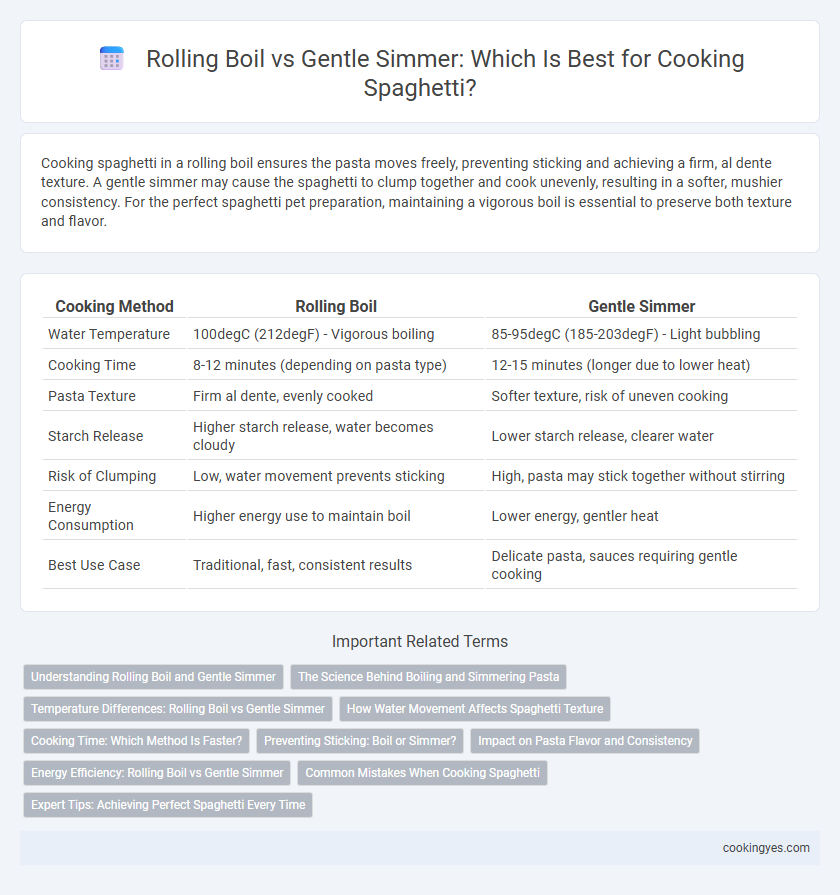Cooking spaghetti in a rolling boil ensures the pasta moves freely, preventing sticking and achieving a firm, al dente texture. A gentle simmer may cause the spaghetti to clump together and cook unevenly, resulting in a softer, mushier consistency. For the perfect spaghetti pet preparation, maintaining a vigorous boil is essential to preserve both texture and flavor.
Table of Comparison
| Cooking Method | Rolling Boil | Gentle Simmer |
|---|---|---|
| Water Temperature | 100degC (212degF) - Vigorous boiling | 85-95degC (185-203degF) - Light bubbling |
| Cooking Time | 8-12 minutes (depending on pasta type) | 12-15 minutes (longer due to lower heat) |
| Pasta Texture | Firm al dente, evenly cooked | Softer texture, risk of uneven cooking |
| Starch Release | Higher starch release, water becomes cloudy | Lower starch release, clearer water |
| Risk of Clumping | Low, water movement prevents sticking | High, pasta may stick together without stirring |
| Energy Consumption | Higher energy use to maintain boil | Lower energy, gentler heat |
| Best Use Case | Traditional, fast, consistent results | Delicate pasta, sauces requiring gentle cooking |
Understanding Rolling Boil and Gentle Simmer
Achieving the perfect texture in spaghetti requires understanding the difference between a rolling boil and a gentle simmer. A rolling boil, characterized by large, vigorous bubbles constantly breaking the surface, ensures rapid cooking and prevents pasta from sticking by keeping water in constant motion. A gentle simmer, with smaller, gentler bubbles barely breaking the surface, is more suitable for delicate sauces but can cause uneven cooking and sticky pasta if used for boiling spaghetti.
The Science Behind Boiling and Simmering Pasta
Rolling boil achieves consistent high heat at 212degF (100degC), ensuring water rapidly cooks spaghetti by evenly breaking down starches and preventing clumping. Gentle simmer at around 185-200degF (85-93degC) slows the cooking process, resulting in firmer pasta texture but risks uneven cooking and increased stickiness. The heat intensity directly influences starch gelatinization and gluten structure, where boiling promotes optimal al dente and simmering may cause mushiness or uneven doneness.
Temperature Differences: Rolling Boil vs Gentle Simmer
Cooking spaghetti at a rolling boil involves maintaining water temperatures close to 212degF (100degC), ensuring rapid, vigorous bubbling that prevents pasta from sticking and cooks it evenly. In contrast, a gentle simmer keeps water just below boiling, around 185-200degF (85-93degC), which slows the cooking process and may cause uneven texture with potential for mushiness. Optimal spaghetti texture and cooking time depend on maintaining a rolling boil for consistent heat and agitation.
How Water Movement Affects Spaghetti Texture
Rapid water movement in a rolling boil keeps spaghetti strands separate, preventing them from sticking together and ensuring even cooking. Gentle simmer causes less turbulence, which may result in clumped noodles and uneven texture. The vigorous agitation of a rolling boil promotes uniform gelatinization of starch, producing ideal al dente spaghetti with a firm yet tender bite.
Cooking Time: Which Method Is Faster?
Rolling boil cooks spaghetti faster by maintaining a high, consistent temperature around 212degF (100degC), allowing pasta to soften quickly and evenly, typically taking 8 to 12 minutes. Gentle simmer, with water below boiling point (around 180degF to 200degF or 82degC to 93degC), slows heat transfer, extending cooking time to 15 minutes or more. Choosing rolling boil accelerates cooking by rapidly breaking down starches and gelatinizing pasta proteins.
Preventing Sticking: Boil or Simmer?
Cooking spaghetti in a rolling boil prevents sticking by keeping the pasta strands in constant motion, reducing the chance they clump together. Simmering at a gentle heat slows the cooking process but increases the risk of the noodles sticking due to less agitation. Maintaining a vigorous boil and stirring frequently optimizes texture and separation for perfectly cooked spaghetti.
Impact on Pasta Flavor and Consistency
Cooking spaghetti in a rolling boil ensures even heat distribution, which helps the pasta maintain a firm texture and prevents it from sticking together, enhancing its al dente quality. Gentle simmering causes the pasta to absorb water unevenly, often resulting in a mushier consistency and less flavorful outcome due to starch leaching into the water. The intense agitation of a rolling boil better preserves the natural wheat flavor and improves overall pasta mouthfeel compared to the subdued heat of a simmer.
Energy Efficiency: Rolling Boil vs Gentle Simmer
Cooking spaghetti at a rolling boil uses significantly more energy due to higher heat levels and constant water agitation, while a gentle simmer maintains steady heat with less energy consumption. Studies show that reducing water temperature from a rolling boil (212degF) to a simmer (around 185degF) can save up to 20% in energy usage without compromising pasta texture. Choosing a gentle simmer optimizes cooking efficiency by balancing adequate heat transfer and minimizing fuel consumption.
Common Mistakes When Cooking Spaghetti
Cooking spaghetti at a rolling boil helps maintain consistent heat, preventing noodles from sticking together and ensuring even cooking, while a gentle simmer can cause clumping and uneven texture. Many home cooks mistakenly reduce to a simmer too early, resulting in gummy and undercooked pasta. Maintaining a vigorous boil throughout the cooking process is crucial for optimal spaghetti texture and overall dish quality.
Expert Tips: Achieving Perfect Spaghetti Every Time
Maintaining a rolling boil when cooking spaghetti ensures even heat distribution and prevents the noodles from sticking together, resulting in al dente texture. A gentle simmer may cause uneven cooking and mushy strands due to lower water agitation and temperature. Experts recommend using a large pot with ample boiling water, stirring occasionally, and timing precisely to achieve perfectly cooked spaghetti every time.
Rolling boil vs Gentle simmer for Cooking spaghetti Infographic

 cookingyes.com
cookingyes.com